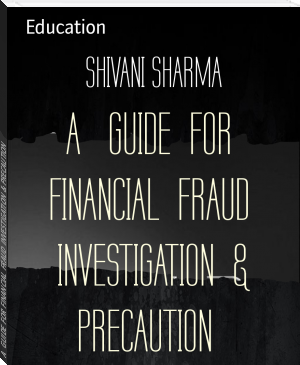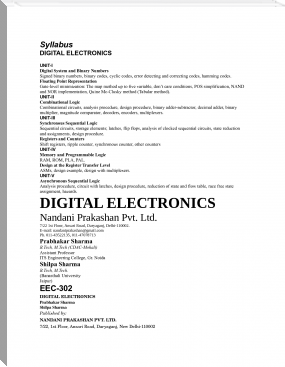A GUIDE FOR FINANCIAL FRAUD INVESTIGATION & PRECAUTION by SHIVANI SHARMA (books to read for beginners .txt) 📕

- Author: SHIVANI SHARMA
Book online «A GUIDE FOR FINANCIAL FRAUD INVESTIGATION & PRECAUTION by SHIVANI SHARMA (books to read for beginners .txt) 📕». Author SHIVANI SHARMA
Identity theft laws are very strict, providing severe punishments for individuals convicted of the crime. Penalties for identity theft may include a fine, forfeiture of any assets or property obtained as a result of the act, and imprisonment for up to 15 years.
Types of Identity Theft
In addition to the obvious reason of obtaining direct financial gain, it is not uncommon for identity theft to be committed in order to facilitate other crimes. According to the Identity Theft Resource Center, there are five distinct types of identity theft. These include:
Identity Cloning and Concealment
This type of identity theft occurs when the perpetrator wants to take on the identity of another in order to conceal his true identity. For example, an illegal immigrant may steal a person’s identity in order to obtain a job in the United States.
Criminal Identity Theft
Criminal identity theft occurs when a person identifies himself as another person to avoid detection by law enforcement, to evade arrest, or to evade prosecution for a crime. Criminal identity theft might enable the perpetrator to commit a crime under the victim’s name, leaving the victim holding the bag. When this occurs, it may be difficult for the victim to clear his name completely, as it is an extensive process that involves the court system.
Synthetic Identity Theft
This crime involves the creation of a completely or partially fabricated identity. This is done by combining an individual’s real social security number with a phony name and made-up date of birth. This type of identity theft is difficult to track, as it may not appear on either person’s credit report. Instead, it may create an entirely new credit report file, or appear on the victim’s report as a sub-file.
Medical Identity Theft
The term medical identity theft, coined in 2006, is a form of insurance fraud. This involves an individual obtaining medical care under another person’s name, using the victim’s name and birth date, and possibly even his insurance policy information. The perpetrator’s medical information would be entered onto the victim’s medical records, and thus exposes the victim to financial losses for medical bills and insurance costs.
Child Identity Theft
The IRS requires that all children claimed as dependents on a parent’s income taxes have their own social security numbers. These social security numbers are valued commodities for fraudsters, as they have no information associated with them. Child identity theft may be committed by a family member or friend, but strangers might use the numbers to apply for loans, obtain credit cards, and even obtain a driver’s license. Because nobody thinks to obtain a child’s credit report, this crime may go undetected for many years.
Signs of Identity Theft
The best way for a person to detect identity theft is to keep track of their bank account and credit card transactions and to check his credit report often. A credit report containing fraudulent or inaccurate information is a major red flag of identity theft, and the individual should immediately question the entries, inquiring further to determine where the information originated. Other signs of identity theft include:
Failing to receive bills in the mail Seeing unexplained bank account withdrawals Being denied credit unexpectedly Having a merchant refuse to accept your check unexpectedly Receiving calls from debt collectors about accounts you are not aware of Receiving bills on accounts you did not know about Receiving notification from the IRS that more than one tax return was received in your nameSigns of medical identity theft include:
Receiving a bill from a medical provider for services you never received Having a legitimate claim denied by your health plan because their records show you have reached your benefits limit Being denied coverage because your medical records show a condition you do not haveIdentity Theft Protection
Identity theft cannot only damage their victim’s credit status, but it can also cost him dearly in money, and invaluable time trying to restore his good credit name. While wily fraudsters make it increasingly difficult for people to guard against identity theft, there are certain steps anyone can take to increase their vigilance in identity theft protection. The number one tip in preventing identity theft is to never carry personal identifying information, such as a social security card. The same goes for keeping such information in their car or another area that is relatively easy for thieves to access.
Other tips for identity theft protection include:
Protect PIN numbers by never writing them on credit/debit cards, or on a slip of paper in a wallet Shield keypads when using ATMs or checkout systems Collect the mail immediately Have the post office hold mail when away for more than a day or two Pay attention to whether bills arrive as scheduled Keep all receipts and account statements Shred unwanted statements or receipts Keep all personal information in a safe place at home Ignore unsolicited requests for personal information Use firewalls on home computers Always use secure passwords Check credit reports annually, or any time theft is suspectedHow to Report Identity Theft
When a person learns that his private information has been compromised, the next step is reporting the theft of personal information. Failing to take appropriate action as soon as the compromise or fraudulent activity occurs may result in greater damage to the victim’s accounts or financial situation. Important steps to remember include:
Make a report to local law enforcement Contact the Federal Trade CommissionPhone: 1-877-ID-THEFT
Mail: Consumer Response Center, FTC, 600 Pennsylvania Avenue, N.W., Washington, DC 20580 Report the theft or breach to your financial institution Contact the local post office if you believe your mail has been stolen Contact the Social Security Administration to report social security number theft or fraud
Phone: (800) 269-0271 Contact the Internal Revenue Service if improper use of identification information is used in connection with tax violations
Phone: (800) 829-0433 Contact any credit or retail companies with which you have accounts which might have been compromised Contact all credit-reporting agencies. In addition to phone and mail services, each agency provides online services for disputing claims, and for reporting identity theft and fraud.
Equifax
Phone: (800) 525-6285
Mail: P.O. Box 740250, Atlanta, GA 30374-0250
Experian
Phone: (888) EXPERIAN (1-888-397-37426)
Mail: P.O. Box 1017, Allen, TX 75013
TransUnion
Phone: (800) 680-7289
Mail: P.O. Box 6790, Fullerton, CA 92634
Identity Theft Statistics
Identity theft is a growing problem in the United States and other countries around the world. Each year, an estimated 15 million people in the U.S. alone have their identities stolen, or their personal information used fraudulently, which causes significant financial losses. The Federal Trade Commission’s Consumer Sentinel Network (“CSN”) compiles identity theft statistics.
In 2014, the CSN received more than 2.5 million complaints, 60 percent of which were fraud complaints, 13 percent of which were identity theft complaints, and 27 percent of which were other types of complaint. An analysis of these complaints provided some interesting information:
Government documents were the most common items used in identify theft, followed by credit cards Only 32% of victims reported their identity theft to law enforcement Of that 32%, only 88% of victims indicate a report was taken or accepted Florida has the highest per-capita rate of reported identity theft, followed by Washington, then OregonIdentity Theft Case
A notorious case of identity theft and fraud involved a convicted felon who incurred over $100,000 in credit card debt, as well as a $200,000 federal home loan and purchased motorcycles and handguns in another man’s name, after stealing his identity. David obtained the man’s social security number and financial information and applied for the loan and credit cards. The man actually called his victim, taunting him, saying he could continue as long as he wanted because identity theft was not a federal crime at that time.
The victim spent more than four years, and $15,000, attempting to restore his credit and good name. The perpetrator served only a short sentence for making a false statement to obtain the firearm and was not ordered to make any restitution to the victim. This occurred prior to and was one of the cases prompting enactment of the Identity Theft and Assumption Deterrence Act of 1998
Pornography
Pornography (often abbreviated porn) is the portrayal of sexual subject matter for the exclusive purpose of sexual arousal.[1] Pornography may be presented in a variety of media, including books, magazines, postcards, photographs, sculpture, drawing, painting, animation, sound recording, phone calls, writing, film, video, and video games. The term applies to the depiction of the act rather than the act itself, and so does not include live exhibitions like sex shows and striptease. The primary subjects of present-day pornographic depictions are pornographic models, who pose for still photographs, and pornographic actors or "porn stars", who perform in pornographic films. If dramatic skills are not involved, a performer in pornographic media may also be called a model.
Various groups within society have considered depictions of a sexual nature immoral, addictive, and noxious, labeling them pornographic, and attempting to have them suppressed under obscenity and other laws, with varying degrees of success. Such works have also often been subject to censorship and other legal restraints to publication, display, or possession, leading in many cases to their loss. Such grounds, and even the definition of pornography, have differed in various historical, cultural, and national contexts.[2]
Social attitudes towards the discussion and presentation of sexuality have become more tolerant in Western countries, and legal definitions of obscenity have become more limited, notably beginning in 1969 with Blue Movie by Andy Warhol, the first adult erotic film depicting explicit sex to receive wide theatrical release in the United States, and the subsequent Golden Age of Porn (1969-1984),[3][4][5] leading to an industry for the production and consumption of pornography in the latter half of the 20th century. The introduction of home video and the Internet saw a boom in the worldwide porn industry that generates billions of dollars annually. Commercialized pornography accounts for over US$2.5 billion in the United States alone,[6] including the production of various media and associated products and services. The general porn industry is between $10-$12 billion in the U.S.[7] In 2006, the world pornography revenue was 97 billion dollars.[8] This industry employs





Comments (0)